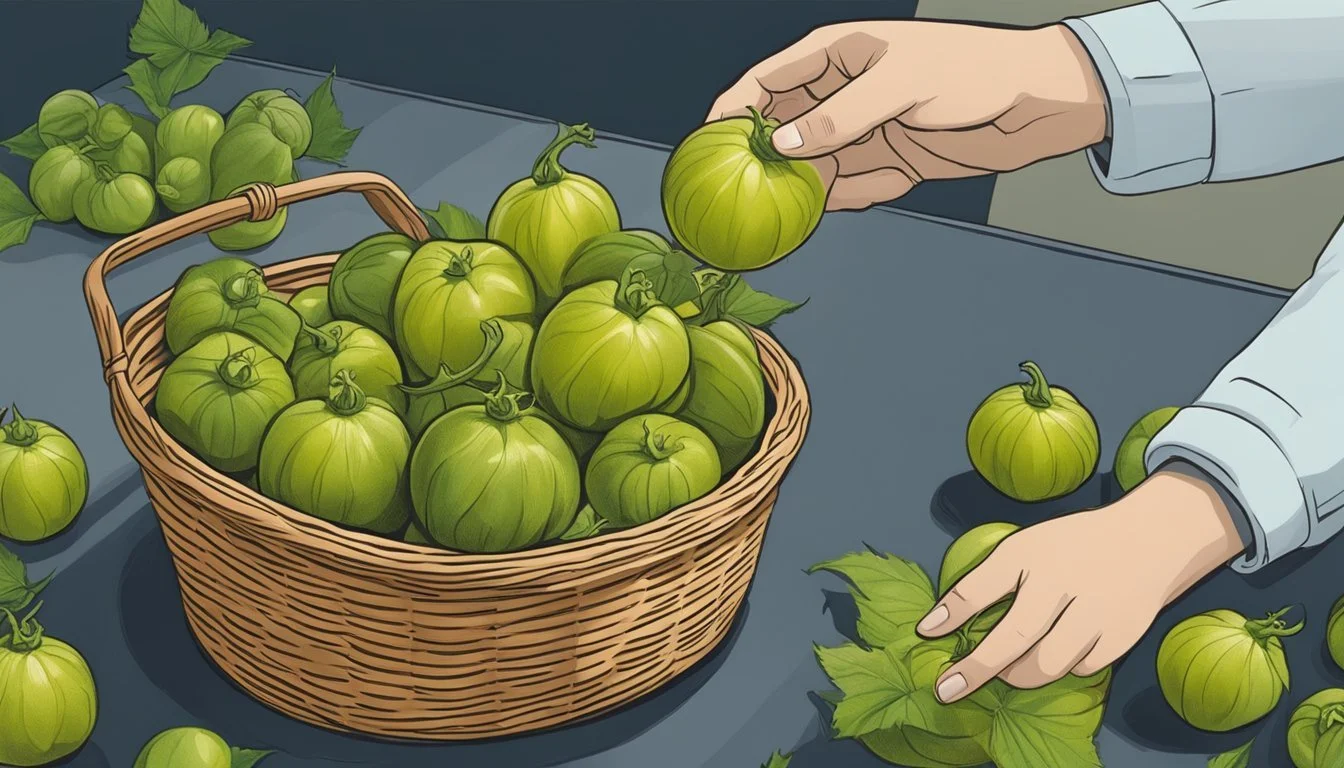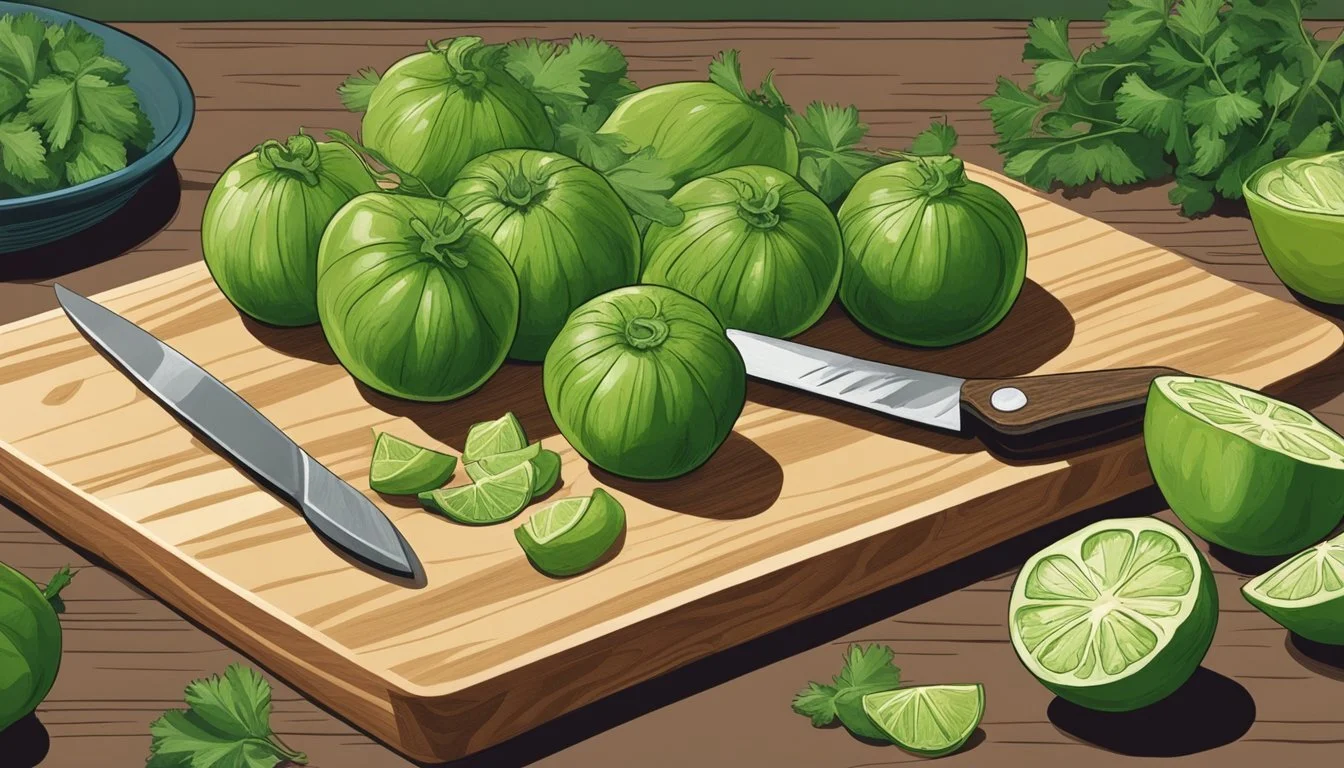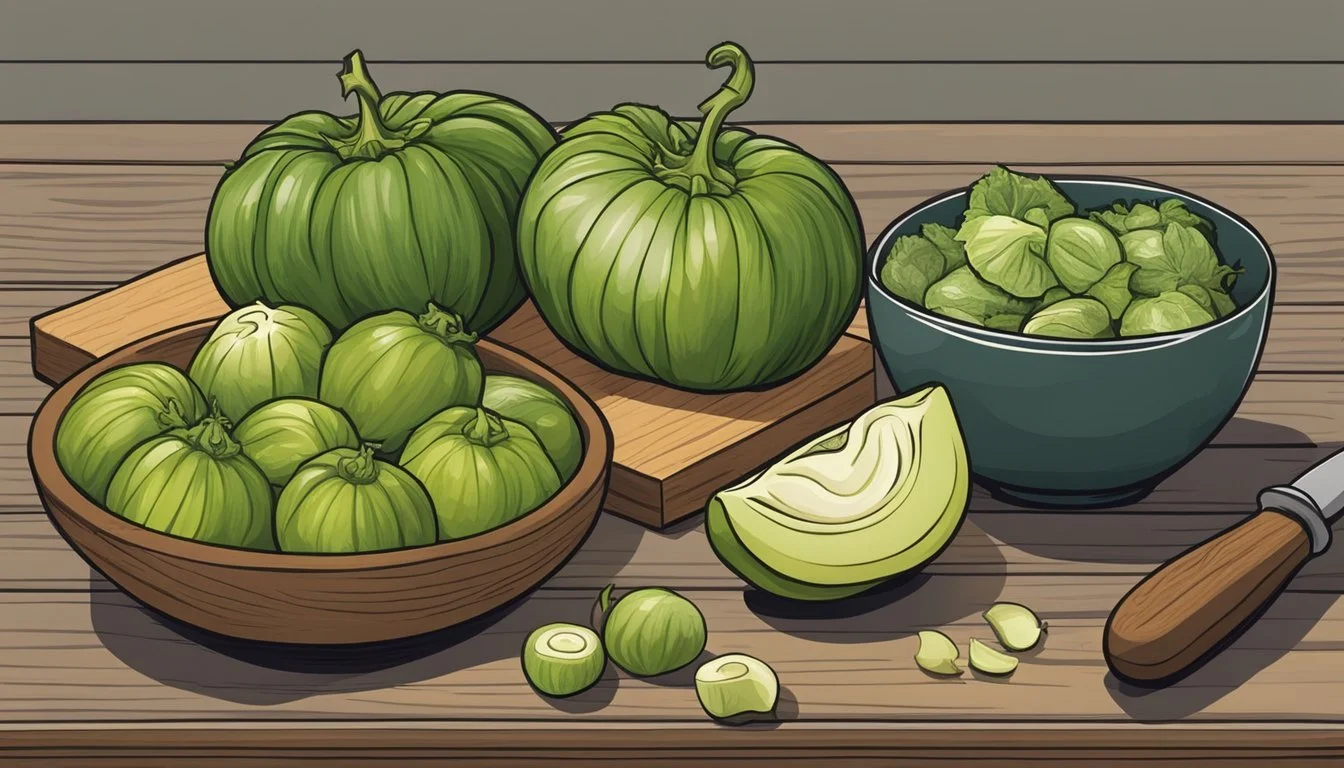How do you eat a tomatillo?
Unveiling the Simple Yet Flavorful Methods
Tomatillos are a distinctive fruit wrapped in a papery husk, and they play a crucial role in Mexican cuisine. They are a staple ingredient, often used to create vibrant and tangy salsas and sauces. Resembling small, green tomatoes, tomatillos have a unique flavor profile that is both tart and slightly sweet. Despite their name translating to "little tomato" in Spanish, they are not just unripe tomatoes but bear their own delicious characteristics.
The husk that encases a tomatillo is more than a mere covering; it's a natural wrapper that signifies freshness. Upon removal of this dry, leaf-like husk, the surface of the tomatillo may feel sticky, but a simple wash under cold water can easily take care of it. Once cleaned and ready to eat, tomatillos can be prepared in numerous ways. They are delicious when eaten raw, providing a crisp texture and refreshing acidity to dishes like salads or ceviches.
Cooking tomatillos unlocks yet another dimension of their flavor, softening their acidic edge and transforming them into ingredients that meld seamlessly into hearty cooked dishes. They can be roasted, grilled, boiled, or blended, each method coaxing out different nuances of their complex taste. Whether used as a central ingredient or a complementary one, tomatillos provide an authentic touch to a variety of recipes, making them a versatile addition to any kitchen pantry.
History and Botany
The tomatillo is a plant with deep historical roots and a rich botanical profile. This section explores its origins in Central America and characterizes its various forms.
Origins and Classification
The tomatillo (Physalis philadelphica), also known as the Mexican husk tomato, is an annual plant that is part of the nightshade family (Solanaceae). It is believed to be native to Mexico and Central America. Botanical evidence traces the existence of the tomatillo back to at least 52 million years ago in Patagonia, but it was cultivated in Mesoamerica in pre-Columbian times. The plant played a significant role in the local diets and has been an integral part of Mexican cuisine for millennia.
Varieties and Characteristics
Different varieties of the tomatillo are known for their unique colors and features:
Green Tomatillo (Physalis ixocarpa): The most common type, typically used when green for a tart flavor.
Yellow and Purple Varieties: These tomatillos tend to be sweeter and are often used in jams and chutneys.
Characteristics of the tomatillo include:
Shape and Size: The fruit is small and spherical.
Husk: The fruit is encased in a thin, paper-like husk which is removed before consumption.
Culinary Use: Tomatillos can be eaten raw or cooked and are a staple in dishes such as salsas and stews (What wine goes well with stews?).
Selecting and Storing Tomatillos
When choosing tomatillos for consumption, one should look for firmness and a bright green color, indicative of ripeness. Proper storage is essential to maintain freshness and flavor, whether at room temperature or in the refrigerator.
Choosing the Best Tomatillos
To ensure the best quality in tomatillos, a person should look for those with a dry and intact paper husk. The fruit itself should be firm to the touch and bright green, as this signifies a ripe tomatillo. They should avoid tomatillos that show signs of wrinkling or sagginess. One should note that tomatillos are related to the cape gooseberry and husk cherry, and though similar in appearance with their paper husks, they have distinct flavor profiles and uses.
Storage Tips
Room Temperature:
Best for short-term storage.
Keep them in a well-ventilated area away from direct sunlight.
Refrigerator:
Place tomatillos in a paper bag in the crisper drawer.
Ideal for prolonging freshness for up to two weeks.
Freezing Method:
Remove husks and wash the tomatillos.
Dry thoroughly.
Cut into desired size.
Arrange on a cookie sheet and freeze to prevent clumping.
Transfer to freezer bags once individually frozen.
By keeping tomatillos in a paper bag rather than an airtight container, one minimizes the risk of mold development. Tomatillos should not be stored in containers that trap moisture, as this can accelerate spoilage. If stored properly in the refrigerator or freezer, tomatillos can keep their freshness and be ready for use in a variety of dishes.
Preparation Techniques
Before indulging in the unique flavor of tomatillos, one must properly prepare them. The process involves peeling the husk, thoroughly washing the fruit, and choosing a suitable cutting and cooking method.
Removing the Husk
The first step in preparing a tomatillo is to remove the papery husk. The fruit will be encased in a loose, parchment-like covering which should be peeled back gently with your fingers. This outer layer is not edible and must be discarded.
Cleaning and Cutting
Once husked, tomatillos have a slightly sticky, waxy surface that requires cleaning. They should be washed under cold running water, using a soft brush if necessary to remove the waxy residue. For cutting, the tomatillos can be chopped in half if they are to be roasted or sliced according to the recipe's specifications.
Cooking Methods
Tomatillos can be incorporated into a variety of dishes and support different cooking methods:
Roasting: Enhances their natural acidity and adds a smoky flavor.
Boiling: Suitable for making sauces, as it softens the fruit without the char of roasting.
Grilling: Imparts a charred flavor, adding complexity to salsas and dishes.
Each method brings out a different aspect of the tomatillo's tangy and slightly acidic taste profile, making them a versatile ingredient in cooking.
Eating Tomatillos Raw
Eating tomatillos raw is a delightful experience for those who enjoy a tart flavor profile in their dishes. They can add a unique acidic edge to salsas and salads, and provide options for healthy snacking.
Salsas and Salads
Tomatillos are a staple ingredient in salsa verde, a tangy and zesty sauce often paired with tortilla chips or used as a condiment for various Mexican dishes. To make a simple tomatillo salsa, one can blend raw tomatillos with ingredients like jalapeños, onions, garlic, cilantro (how long does cilantro last?), and lime juice. The acidity of the tomatillos, paired with the citrus from the lime juice, creates a bright and refreshing flavor that enhances the overall taste of the salsa.
They can also contribute a unique flavor to salads. When diced, tomatillos introduce a refreshing acidity and mild sweetness. They are an excellent complement to leafy greens and can be balanced with creamy dressings or avocado, such as in a tomatillo-avocado salad.
Snacking Options
Tomatillos can also be consumed as a raw snack. Their tart flavor is a pleasant addition to a crudité platter and goes well with a range of dips, including guacamole. To prepare tomatillos for snacking, simply rinse them under cold water to remove the waxy residue and slice them into wedges. The juicy crunch they provide is not only satisfying but also low in calories, making them a smart choice for a nutritious snack.
Cooked Tomatillo Dishes
Tomatillos, with their tangy flavor and bright green color, are a staple in many cooked dishes. They add depth and authenticity to traditional Mexican cuisine and inspire innovation in modern recipes.
Traditional Mexican Cuisine
In Mexican cooking, tomatillos are widely used to create salsa verde, a green sauce that enhances the taste of countless dishes. They are an essential ingredient in enchiladas verdes, where the salsa blankets soft tortillas stuffed with meats or cheeses. Pozole verde, a hearty hominy stew, derives its vibrant color and unique flavor from the tartness of cooked tomatillos. Similarly, chile verde centers around the simmering of these fruits to produce a rich and aromatic sauce, typically served with braised pork.
Enchiladas: Salsa verde coating, filled with chicken, cheese, or beef
Pozole Verde: Hominy stew with a base of pureed tomatillos, seasoned with garlic and chilies
Chile Verde: Braised pork in a savory green sauce of tomatillos and green chilies
Modern Recipes and Pairings
Adventurous chefs might incorporate tomatillos into modern recipes, pairing them with unexpected ingredients to add a pop of color and flavor. Tomatillos can be blended into sauces for a zesty twist on huevos rancheros or mixed into scrambled eggs to brighten up a breakfast dish. In contemporary kitchens, creative cooks might also use this Mexican husk tomato in soups and stews that diverge from traditional recipes, combining them with ingredients not typically associated with Mexican cuisine.
Huevos Rancheros: Topped with tomatillo salsa for a fresh take
Scrambled Eggs: Folded with roasted tomatillos for a zesty breakfast option
Soups and Stews: Use tomatillos as the tangy backbone for innovative creations
Recipe Development
Developing recipes with tomatillos involves crafting a flavorful base and exploring innovative uses of the fruit across a range of dishes. The tartness reminiscent of an apple and a lemon adds a unique twist to both classic and adventurous culinary creations.
Creating a Tomatillo Base
The first step in recipe development with tomatillos is to create a versatile base that can be utilized in various recipes. They should be husked and washed to remove the waxy film. Here's how to prepare a simple tomatillo base:
Cleaning: Remove the paper husks and rinse the tomatillos under cold water.
Cooking: They can be chopped and used raw for a bright, acidic flavor, or cooked to mellow their tartness. Boil, grill, or roast them until they soften.
Blending: Blend the cooked tomatillos to form a puree that can serve as a foundation for sauces and salsas.
Recipes leveraging a tomatillo base often incorporate ingredients like onions, cilantro, and chili peppers to complement the tomatillo's zesty flavor.
Innovative Uses in Various Dishes
With a tomatillo base in hand, chefs can innovate across various dishes:
Salsas and Sauces: The classic use is in salsa verde, where pureed tomatillos mix with chili peppers, onions, and cilantro.
Salads: Chopped tomatillos add a fresh, summery vibe to an avocado salad, with their tanginess dressing the greens.
Main Courses: Incorporate them into chicken or pork recipes for a touch of brightness. One could also consider them for stuffing in a burger for a zesty twist.
Soups: Tomatillos can be a starring ingredient in chilled summer soups or a tangy complement in hearty winter ones.
Cocktails: Muddle raw tomatillos for a cocktail base that pairs well with summer spirits.
Each use taps into the tomatillo's refreshing flavor profile, enhancing dishes with both a visual and a taste appeal, always allowing the tomatillo to shine without overpowering other ingredients.
Health and Nutrition
When it comes to nutrition, ripe tomatillos stand out in various ways. These small, spherical fruits, often encased in papery leaves, are known for their bright, tart flavor and are a staple in Mexican cuisine. Notably, tomatillos are rich in vitamins and minerals and are especially beneficial when included in a balanced diet.
Nutrients in Tomatillos:
Vitamins: Tomatillos are a good source of vitamin C and vitamin A, which are powerful antioxidants. Additionally, they contain vitamin K and niacin (vitamin B3), supporting bodily functions such as blood clotting and cholesterol management.
Minerals: They offer essential minerals, with potassium being particularly substantial. Potassium aids in maintaining healthy blood pressure levels. Small amounts of iron, magnesium, and phosphorus are also present, contributing to overall health.
Nutritional Benefits:
Fiber: One can benefit from the dietary fiber in tomatillos, which is important for digestive health.
Low in Calories: A serving is low in calories, making tomatillos a weight-friendly addition to one's diet.
Antioxidant Properties: Apart from vitamins, the fruit contains other antioxidants such as lutein and zeaxanthin, known for their role in eye health.
The tartness of ripe tomatillos not only adds a unique flavor to dishes but also indicates the presence of bioactive compounds that offer health-promoting properties. While the leaves are not consumed, they serve to protect the fruit and are removed before eating. In summary, tomatillos are nutrient-dense and can play a significant role in maintaining overall health.
Gardening Tips
Growing tomatillos in one's garden provides a vibrant addition to summer crops, boasting lantern-shaped husks that encapsulate the fruit. It's essential for the gardener to focus on proper cultivation techniques and pest management to ensure a healthy tomatillo harvest.
Cultivating Tomatillos at Home
Tomatillos are typically grown from seeds, which should be planted at a quarter-inch depth in well-drained, nutrient-rich soil. They require full sunlight, so one should choose an area in the garden that receives ample sun throughout the day. Here's a quick guide to ensuring a successful planting:
Soil Preparation: Work compost or well-rotted manure into the soil to promote fertility. Tomatillos thrive in soil with a pH between 6.0 and 7.0.
Seed Spacing: Space seeds or seedlings about 18-24 inches apart with rows spaced 3 feet apart. This gives tomatillo plants room to grow and ensures ample air circulation.
Watering Needs: Provide 1-2 inches of water per week, maintaining consistent moisture levels without overwatering.
Pest Management and Plant Care
While tomatillos are hardy, they can fall prey to pests and diseases common to the nightshade family, such as flea beetles and tomato hornworms. One should monitor their plants regularly for signs of pest activity. For plant care, follow these practices:
Organic Pesticides: Use organic solutions like neem oil to manage pests, applying as per the product instructions.
Regular Checks: Inspect plants often for signs of damage or disease, which could indicate pest infestations.
Remember, tomatillos require summer warmth and are less tolerant of cooler temperatures. Taking preventative measures against pests and providing the right growing conditions are critical for yielding a bountiful tomatillo crop.
Storage and Preservation
Proper storage and preservation are crucial for maintaining the tart flavor and firm texture of tomatillos. These methods prevent the fruit, commonly mistaken for a green tomato, from spoilage and allow for future use in various recipes, such as salsa and salsa verde.
Canning and Pickling
Canning is an effective method to extend the shelf life of tomatillos and preserve their unique flavor for later use. Ensuring that they are adequately sealed in airtight containers, tomatillos can be incorporated into salsas or salsa verde and canned for long-term storage.
Pickling involves cutting the tomatillos into quarters or slices and then immersing them in a mixture of vinegar, water, sugar, salt, and spices brought to a boil. This mixture is then poured over the tomatillos and sealed tightly. Pickled tomatillos can be stored in the refrigerator for up to one month.
Freezing Techniques
Freezing tomatillos is a straightforward preservation technique. One should:
Remove the husk and stem.
Wash and dry the fruit thoroughly.
Freeze whole or sliced on a baking sheet before transferring to a freezer bag, which prevents clumping and allows one to remove only the desired amount.
This method enables one to retain the tomatillos' tart flavor, making them readily available for recipes like salsa verde.
Drying and Dehydrating
Drying tomatillos can give a more concentrated flavor and is best for those looking to use tomatillos in dry form for seasoning blends or ground powders. Dehydration involves:
Slicing the fruit evenly to ensure consistent drying.
Using a food dehydrator or an oven set at the lowest temperature until the tomatillos are brittle and devoid of moisture.
One should store the dried tomatillos in a cool, dark place to ensure they maintain their quality. This method is especially suitable for those seeking to enjoy the essence of tomatillos, with a more intensified flavor, in dishes that incorporate peppers and other seasonings.
Food Safety
When it comes to eating tomatillos, it's important to be informed about their toxicity and how to handle them safely. As a member of the nightshade family, tomatillos are closely related to other produce like tomatoes and eggplants, but concerns about toxicity mostly pertain to their leaves and stems, not the fruit itself.
Understanding Toxicity
Tomatillos, though encased in a husk and sometimes having a sticky residue on the skin, are not toxic and can be safely consumed. The primary concern for toxicity with tomatillos lies with their foliage and stems, which should not be ingested as they contain solanine—a compound that can be toxic in large quantities. However, the fruit of tomatillos, which is commonly used in cooking, does not typically present any risk when consumed. They are in fact, nutritious and form an integral part of various cuisines.
Precautionary Measures
To ensure that tomatillos are safe to eat, follow these precautionary steps:
Remove Husks: Before using tomatillos, one must always remove the dry, leafy husks that cover the fruit.
Wash Thoroughly: After husking, wash the tomatillos under cold running water to remove the naturally occurring waxy film.
Inspect the Fruit: Visually inspect the tomatillo for any signs of spoilage or damage. It's essential to use only fresh, undamaged fruits for consumption.
Following these steps will help to mitigate any safety concerns when preparing and consuming tomatillos.
Culinary Inspirations
Tomatillos, a staple in Mexican and Central American cuisines, offer a unique tart flavor that enhances a variety of dishes. When ripe, these small green fruits, encased in a papery husk, are usually cooked to soften their tartness, making them a versatile ingredient for sauces and condiments.
Salsa Verde: A classic Mexican sauce, crafted from tomatillos, chiles, cilantro, and onion, provides a vibrant, tangy complement to many dishes. It's commonly served with tortilla chips or as a topping for tacos.
Tomatillo Guacamole: The fruit can be blended into guacamole for an extra kick of acidity, pairing well with rich avocados.
For breakfast, it’s traditional to see tomatillos incorporated into dishes like Huevos Rancheros, where a tomatillo-based salsa adds zest to fried eggs served over tortillas. Another breakfast favorite is tomatillo salsa paired with eggs and beans in a hearty Chilaquiles.
Proteins and Stews: Shredded pork simmers excellently in a tomatillo-based sauce, absorbing its acidic notes, creating a balance of flavors. Similar uses include chicken or beef curries, where tomatillos can introduce a new dimension to the flavor profile.
In summary, tomatillos can be enjoyed raw or cooked, integrated into salsas, guacamole, or as a tangy addition to curries and breakfast dishes. Their role as a flavor-enhancer in sauces and stews is well-regarded, making them an essential ingredient in authentic Mexican and Central American cooking.
Frequently Asked Questions
The following section addresses commonly raised questions about tomatillos, including selection and culinary utilization, and provides expert guidance for enhancing dishes with this unique ingredient.
Addressing Common Concerns
Q: How does one select the best tomatillos?
A: One should look for tomatillos that have a bright green color and are firm to the touch. The papery husks should be intact but can be removed before cooking.
Q: What is the correct way to soften tomatillos for cooking?
A: Tomatillos can be softened by roasting, simmering, or steaming. Each method brings out different flavors suitable for various recipes, such as enchiladas or sauces.
Q: Can tomatillos replace tomatoes in recipes?
A: Yes, tomatillos can be used as a substitute for green tomatoes, offering a tangy flavor that works well in salsas, dressings, and as a topping for burgers or chicken.
Tips from the Chef
Preparation: To prepare tomatillos, they must first be freed from their papery husks and then washed to remove the waxy film. This ensures the fruit is clean and ready for cooking or raw consumption.
Cooking Techniques:
Roasting: This method enhances the tomatillos' natural flavors and is ideal for salsas and sauces.
Simmering: Tomatillos can be simmered to integrate into stews or sauces, contributing a balanced acidity.
Service Suggestions:
For a vibrant salad dressing, blend raw tomatillos until smooth.
When making burgers or chicken, consider topping them with roasted tomatillos to add a piquant twist.
Remember, tomatillos add a unique tartness that can be moderated by cooking. They are not just a stand-in for red tomatoes but are rather an independent ingredient that elevates the taste of various dishes.
Pairing and Serving Ideas
Tomatillos bring a unique tangy flavor to a variety of dishes. They are versatile in application, making them an excellent choice for enhancing both food and beverages with their bright, citrusy taste.
Beverage Combinations
When considering beverages to pair with tomatillos, the goal is to complement their tartness without overwhelming the palate. A crisp cider or a light lager can be refreshing alongside tomatillo-based dishes. In the realm of non-alcoholic drinks, a lemon or apple-infused sparkling water can echo the fruity acids found in the tomatillo, providing a harmonious balance.
Complementary Foods
Tomatillos excel in salsas and sauces, particularly when roasted to bring out their full flavor. Their crisp acidity pairs well with creamy elements such as avocado in guacamole or as a garnish in salads. One can employ tomatillos as a base or an accent in soups, stews, and curries, adding a vibrant layer of taste that cuts through the richness of these dishes.
Enchiladas: Tomatillos serve as the main ingredient in a zesty green enchilada sauce.
Dips: A simple salsa verde made with tomatillos can act as a versatile dip for tortilla chips or a complementary side for burgers.
Engaging tomatillos in various culinary roles not only leverages their distinctive flavor but also boosts the overall taste experience of a meal. Whether incorporated raw, roasted, or cooked down into a condiment, their ability to impart a fresh, citrus-like essence makes them a noteworthy ingredient in a cook's arsenal.
Conclusion
Tomatillos offer a unique and tangy flavor to a variety of dishes. They are an integral part of Mexican cuisine and can be harnessed in numerous recipes, from raw salsas to cooked sauces. Their bright, acidic taste adds depth to foods when chopped and incorporated raw, providing a fresh zing to salads, tacos, and more.
Cooking with tomatillos is simple and versatile. It can roast, bake, grill, or blend them to suit different culinary applications. When roasted, their flavor deepens, lending a smoky note to salsas and sauces that is highly desirable in dishes like enchiladas or chilaquiles. Blending tomatillos creates a smooth base for a variety of sauces and dips, ensuring that their distinct taste is dispersed evenly throughout the dish.
Raw: Chop and add to salads or salsas for a fresh, acidic touch.
Roasted: Enhance their flavor for hearty and rich sauces.
Grilled: Impart a smoky taste in meal accompaniments.
Blended: Create smooth and even-textured bases for dips.
In any situation where a touch of tartness or freshness is desired, tomatillos are an excellent choice. They offer a pleasing balance to savory dishes and work well with other common ingredients such as onions, cilantro, and chili peppers. Through experimentation with tomatillos in cooking, one can explore the rich tapestry of flavors that this small, spherical fruit has to offer.











